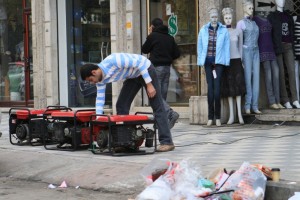Doctors get warm welcome in Gaza
(This is Part 2 of a series. For the next several days, Gerri Haynes, a former president of Washington Physicians for Social Responsibility, will be sending back reports from inside blockaded Gaza. As she did twice before, Gerri has organized a team of doctors and other health care providers to work in hospitals and clinics in Gaza in an effor t to directly help the people there and to bring attention to the ongoing humanitarian crisis that the Israeli blockade has created.)
The Mediterranean is frosty-looking and the pewter sky breaks to a cool sun, but the open-air prison that is Gaza is constantly warmed by the generous spirit of the people here.
To enter Gaza, our application was submitted at the beginning of October, 2010. After many telephone and email contacts with Israeli authorities, permission to enter was received on January 11, 2011. Still, we, eight of us, were required to wait at the entry point for nearly two hours in the chilly breeze and intermittent showers for the gate to be opened.
We were delighted to receive the warm greetings of our Gazan friends. This afternoon, our hosts, the Gaza Community Medical Health Programme, held an organizing meeting with personnel and directors from the hospitals and clinics where we will be working.By evening, Drs. Rich Grady and Ismael Zamilpa, pediatric urologists, were operating on some of the children who had been assembled for care.
In our afternoon meeting, we heard that the difficulties of life in Gaza have not changed greatly since our May, 2010 visit. Following the disaster of the attacks on Marvi Marmara humanitarian relief flotilla (May, 2010), there was a promise from Israel that more goods would be allowed to enter Gaza. This promise was referred to by our hosts as “window dressing” since there has been no remarkable increase in desperately needed goods and building materials required to repair the bomb damage suffered in Operation Cast Lead (December 2009-January 2010) are not available.
A new type of employment has been created: recovering materials from buildings destroyed by bombing. These materials do not provide essential strength for safe buildings however, and the possible toxic residue from bombs make the materials suspect.
Several members of our delegation took a brief tour along the coast of Gaza and into the city to witness that: raw sewage still flows into the Mediterranean (sewage treatment facilities are extremely limited due to bomb damage and cuts in electricity), fishing boats are still beached because Israel does not permit deep-sea fishing off the coast of Gaza, and the air remains polluted with the fumes cast off by the generators required for commerce, medical care and home life.
Tomorrow is a work day.
1 Comment to “Doctors get warm welcome in Gaza”
RSS feed for comments on this post. TrackBack URI

By Bert Sacks, January 17, 2011 @ 7:29 pm
What great work this team of dedicated health professionals are doing … not only on the physical, medical level, but bringing hope and caring to a population so cut off from the rest of the world. It is a reminder to the people of Gaza that there are people outside who care.